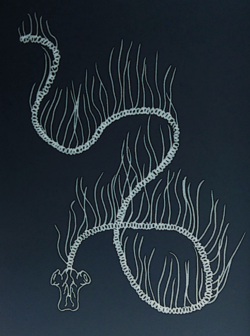| Prayidae | |
|---|---|
 | |
| Illustration of Praya dubia | |
| Scientific classification | |
| Kingdom: | Animalia |
| Phylum: | Cnidaria |
| Class: | Hydrozoa |
| Order: | Siphonophorae |
| Suborder: | Calycophorae |
| Family: | Prayidae Kölliker, 1853 |
Prayidae is a family of marine invertebrates in the order Siphonophorae. They are colonial, and the colonies can superficially resemble jellyfish; although they appear to be a single organism, each specimen is actually a colony of Siphonophora.
The family contains the following subfamilies and genera: [1]
- Subfamily Amphicaryoninae Chun, 1888
- Genus Amphicaryon Chun, 1888
- Genus Maresearsia Totton, 1954
- Subfamily Nectopyramidinae Bigelow, 1911
- Genus Nectadamas Pugh, 1992
- Genus Nectopyramis Bigelow, 1911
- Subfamily Prayinae Chun, 1885
- Genus Craseoa Pugh & Harbison, 1987
- Genus Desmophyes Haeckel, 1888
- Genus Gymnopraia Haddock, Dunn & Pugh, 2005
- Genus Lilyopsis Chun, 1885
- Genus Mistoprayina Pugh & Harbison, 1987
- Genus Praya Quoy & Gaimard, in de Blainville, 1834
- Genus Prayola Carré, C. 1969
- Genus Rosacea Quoy & Gaimard, 1827
- Genus Stephanophyes Chun, 1888